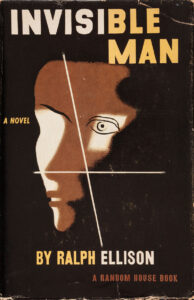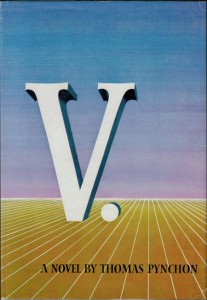I first came across a mention of Dick Schaap‘s 1964 article about Thomas Pynchon’s efforts to remain out of the public eye via a New York Times article “Pynchon’s Letters Nudge His Mask” (4 March 1998), which included a passage about to Pynchon’s success in avoiding the press after the publication of his first novel, V. (1963):
Although Mr. Pynchon apparently eluded those magazine reporters, he had a more difficult time with Dick Schaap, who in 1964 was the city editor of The New York Herald Tribune. Mr. Schaap was writing an article about Mr. Pynchon for Book Week, The Tribune‘s literary supplement. Mr. Pynchon was furious, assuming that the piece ‘will be riddled with the same lies, calumnies and all-around knavish disregard for my privacy’ as previous articles.
When the Herald Tribune article is printed, Mr. Pynchon buys the newspaper in Mexico. It makes him ‘sick, almost homicidal,’ especially the comments about a former girlfriend.
In response to Mr. Pynchon’s remarks, Mr. Schaap, an author and television commentator, said recently, ‘Nothing in my article was intended to be damaging to his life or his work, for which I have total respect.’
Although Mr. Schaap’s reputation rested firmly on his sports writing, here he was digging around to locate the whereabouts of a recently minted literary star. His article, which appeared in the New York Herald Tribune‘s “Book Week” magazine, provides an interesting glimpse into Pynchon’s early efforts to remain out of the public eye. A colleague of mine believes that what might have most annoyed Pynchon was the article’s “chatty knowingness.”
No Return Address On The V-Mail
by Dick Schaap
Book Week, 10 May 1964
His name is Thomas Pynchon, and he wrote V., but who is P.?
 The question would hardly be worth asking if he were not a hugely gifted and imaginative new writer whose V. has been one of the most celebrated first novels since, say, Ralph Ellison’s The Invisible Man. The suspicion exists that P. is The Invisible Man.
The question would hardly be worth asking if he were not a hugely gifted and imaginative new writer whose V. has been one of the most celebrated first novels since, say, Ralph Ellison’s The Invisible Man. The suspicion exists that P. is The Invisible Man.
Sandy Richardson, who is his editor at Lippincott, has never seen P.
Isabelle Holland, who writes the press releases at Lippincott, has never seen P.
Keith Botsford, who, as co-editor of The Noble Savage, published a short story that evolved into a segment of V., has never seen P.
Even the people who have seen P. find it difficult to agree upon what they’ve seen. And most of them haven’t seen him lately.
His mother, a Long Island housewife, says P. is six feet, four inches tall. She hasn’t seen him in a few years.
A young lady who was once in love with him, and loved by him [1]From a Vulture article (25 Aug 2013) by Boris Kachka: “He had doubts about his lyrical talents, though ‘I have this guitar on which I occasionally kill time making up rock ‘n’ roll … Continue reading, says P. is about six feet, two inches tall. After her parents decreed that a marriage between her, Jewish, and him, Catholic, wouldn’t work, she has seen him only rarely, not at all since she finished college in 1961. She is married now, to a doctor.
Cork Smith, who edited V. for Lippincott before switching over to Viking, says P. is roughly six feet tall. Smith met him once, for 30 minutes over beers in a Seattle hotel bar, asked him if he wanted to talk about the novel in progress, took no for an answer and, instead, chatted about Boeing Aircraft, where P., then, in 1960, was working as a technical writer.
Michael Curtis, an Atlantic Monthly editor who roomed with P. when he was between Cornell University and V., says P. is approximately five feet, ten inches tall. Curtis hasn’t seen him in four years.
“Above all, Pynchon was a saintly man,” Mike Curtis recalls. “When he showed his work around, it was always with the sense that it was fatally flawed, and he counted on the rest of us to show him the way. He listened patiently and sincerely to all our criticisms, most of which, needless to say, were brutish and stupid, and seemed to imply that if we would only have patience, he’d try to do better. We all loved him.”
Everyone who has known him seems to agree that no matter his height, Pynchon was or is unusually thin, had or has black hair, and sported or sports a mustache — handlebar or trim — and sometimes a goatee, sometimes both, sometimes neither. The friends of Thomas Pynchon share a fondness for calling him a genius, a saint, an overly harsh self-critic, a letter-writer without peer and a master of every scholarly discipline from higher mathematics to Greek.
Mother, ex-girl friend, ex-editor and ex-roommate have a common curse: Each of them, to contact Pynchon, must follow the same route — through his literary agent, Candida Donadio.
Miss Donadio is, at Pynchon’s request, a reluctant link. She will admit that he exists, but only if pressed. She confesses that she talks to him on the phone, but considers the frequency of those conversations a state secret. She shows his letters to no one and, most likely, chews and swallows the envelopes as soon as she memorizes his latest address.
 When it comes to close-mouthedness, Pynchon himself makes J.D. Salinger look like a publicity hound. When his novel appeared a year ago — it has sold some 8,000 copies in hard cover, came out in Bantam Book paperback two months ago and now has 310,000 copies in print — he fled from the West Coast to Mexico out of sheer shyness.
When it comes to close-mouthedness, Pynchon himself makes J.D. Salinger look like a publicity hound. When his novel appeared a year ago — it has sold some 8,000 copies in hard cover, came out in Bantam Book paperback two months ago and now has 310,000 copies in print — he fled from the West Coast to Mexico out of sheer shyness.
When he was nominated several months ago for the National Book Award in fiction, Pynchon briefly considered coming to New York for the ceremony, then abandoned the idea and retreated once more to Mexico.
Yet Pynchon’s iron screen of privacy occasionally lifts, and information does slip out. Last week, as he celebrated his 27th birthday, Pynchon was in his current Mexican hideout, in Guadalajara, at work on his second novel, which is the one subject he never discusses in fact-filled letters to his editor.
Pre-Mexican history? He was born Thomas R. Pynchon II, in Glen Cove, Long Island, grew up in nearby Oyster Bay, where his Republican father was active in politics and, eventually, town supervisor. The father lost his post six months ago to a Democrat, a stunning reversal in Republican Oyster Bay. The oldest of three children — his one sister writes poetry and teaches English — Pynchon was valedictorian of his grammar-school class, slumped to salutatorian of his Oyster Bay High School class.
Pynchon graduated from Oyster Bay High in 1953, barely 16 years old, went up to Cornell to study engineering physics, the most rugged academic course the school offers, stayed two years and dropped out to join the Navy.
After two Navy years, filled largely with carousing and reading, he went back to Cornell and finished up in June, 1959, as an English major. He rarely got a grade below 90, maintained — according to English Prof. Baxter Hathaway — an average around 93 and graduated second or third in his class.
He spent the next summer in Ithaca, sold four short stories (two of which wound up in prize-winning anthologies), soon was sent by editor Jim Silverman of Dial Press, who liked him but not enough to publish him, to Candida Donadio. She helped Pynchon get a $500 advance from Lippincott, and, in 1959, he started writing V., in a friend’s New York apartment. Life in the city chased him to Seattle, where Boeing paid for his combined mathematical-literary talents, and by 1962, he finished the novel. Editing changes were minor, most of them initiated by Pynchon himself, and the novel came out to, generally, glowing notices.
Pynchon promptly disappeared, and except for an occasional outing — he was best man when a former roommate, Dick Fariña, married the younger sister of folk singer Joan Baez — has been hiding and writing since.
Footnotes
| ↑1 | From a Vulture article (25 Aug 2013) by Boris Kachka: “He had doubts about his lyrical talents, though ‘I have this guitar on which I occasionally kill time making up rock ‘n’ roll lyrics.’ As for where he’d like to work, ‘Chicago is where my girl goes to school.’
That girl and that fellowship may have presented, for Pynchon, an opportunity for a middle-class life—steady income, a wife, a starter home. Toward the end of school, he’d gotten into a serious relationship with Lilian Laufgraben. They might have married, but her parents disapproved of her dating anyone who wasn’t Jewish. Jules Siegel, in a 1977 Playboy exposé on his ex-friend Tom, got her name wrong (possibly on purpose) as ‘Ellen Landgraben,’ and until now only close friends knew her real name. In 1962, Laufgraben married a psychiatrist. (Today they live not far from Pynchon, but refuse to discuss the connection.) Pynchon gave the breakup as a reason to skip Kirk Sale’s New York wedding to a mutual friend, Faith, who edited early drafts of V. Lilian, he wrote, was getting married to ‘a nice safe Reformed-temple medical student from her hometown, and this is enough to blight the entire area for me.’ A mutual friend, C. Michael Curtis, believes that the nose-job interlude in V., in which Jewish princess Esther is graphically carved up, was Pynchon’s ‘way of exorcising his angry feeling about losing her.’ |
|---|
Leave a Reply